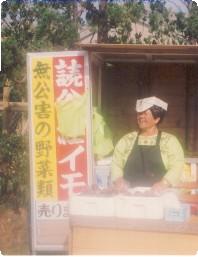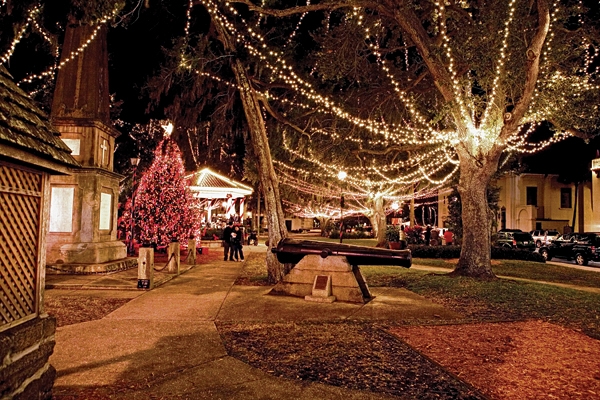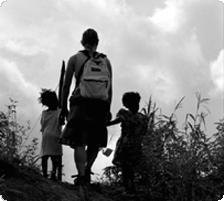Culture: Japan: Finding Myself in Japan
by Sherrie Bakshi
As a child, it never dawned on me that one day I would tell people I grew up in Japan. I moved to Okinawa, Japan, when I was eleven years old, longing to return to the normalcy of my life in the United States. But that soon changed.
Today, when someone asks where I am from, it takes me a few minutes to answer. I was born in the United States, but I spent a large portion of my life abroad. Many of my habits and my outlook on life developed from my experiences abroad, and transformed me from a girl into a young woman.
My family moved to Okinawa with the intention of returning to the United States in three years. This plan changed after my father decided to extend our stay a bit longer. Transition from life in the United States to Japan was difficult at first, but after exploring the island and making connections with the locals, I found myself inspired by, and comfortable with, my surroundings.
Okinawa is part of the Ryukyu Islands; it is located approximately 300 miles from mainland Japan and 200 miles from China. Its inhabitants are called Okinawans, and are believed to be a mixture of Japanese, Korean, and Chinese descent. And while Japanese remains the island’s official language, many elderly Okinawans speak Okinawan, a mixture of Japanese and Chinese.
During World War II, the small island was the site of one of the war’s bloodiest battles. Thousands of people lost their lives, and the island was left in ruins. Today, Okinawa is a vacation hotspot and home to more than seventy thousand Americans and more than one-hundred thousand Japanese.
I lived in Okinawa in the late 1980s through the mid-1990s; during this period, the country was going through an economic boom, spawning and exporting massive quantities of automobiles and electronics to the United States and Europe. While many Americans and Europeans enjoyed these Japanese luxuries, Okinowans maintained their normal lifestyle. They remained
strongly connected to their heritage, their culture, and their families—this was evident everywhere. The island’s parks, temples, and other family-friendly attractions, including amusement parks and zoos, were always filled with young couples and families enjoying picnics in the subtropical temperatures and natural environs.
In Okinawa, my parents and I enjoyed perusing the local shops. The environment was so safe and comfortable that while parents shopped, kids crowded around the televisions and watched the latest episodes of the popular Japanese cartoon Dragon Ball Z2. This carefree lack of supervision is something that would almost never happen in the United States, but was fairly common in Japan at the time. Upon entering a store, employees greeted us with an enthusiastic, Irasshai Masai. Following the custom, we acknowledged them with a smile and thanks.
Many of the area’s popular stores offered similar products to those sold at Target and Wal-Mart in the States, except everything was much smaller. The dishwashers and washing machines were bright shades of pinks and blues; they looked like toys you would find in a child’s playroom. The products were too small for an American home, but fit perfectly in Japan. Homes in Japan are much smaller than homes in the United States, and space is valued, so when it comes to necessity versus luxury, Japanese are more likely to spend their money on the things that they need versus the things that they want.
The Japanese philosophy of simplicity and respect developed from Shintoism, a religion indigenous to Japan. A majority of Japanese are Shintos, followed by a small number of Buddhists and Christians. Shintos believe that Kami (God) is found throughout the natural world; Kami is found in all the natural wonders, including mountains and oceans, as well as in animals. For a Shinto, throwing trash on the ground is a sign of disrespect to the earth. Shintos also pray to their ancestors, past emperors, and heroes to protect them from the evils of the world. Founded in the fourth century, Shintoism developed from Buddhism and Chinese religions. The fundamentals of this religion define the Japanese way of life.
Every Friday, I visited the temple near my house, hoping to receive blessings from Kami. During these moments, I reconnected with my spiritual side. Shinto temples and castles are symbolized by Toris. Upon passing through the archways, one leaves the human world, and enters the world of Kami. The temple is opened to everyone. Upon entering, one first
gives an offering to the Kami, and follows it with a bow as a sign of respect.
My connection to Buddhism also began in Okinawa. On special occasions, my family traveled to a Buddhist temple, located on one of Okinawa’s highest mountains. Our Mamasan explained to me that Okinawans only journeyed to the Buddhist temple for significant events. The temple sat alone on the mountain; it was the home to a small number of Buddhist monks, who spent most of their days in meditation. Upon arrival, the head priest, draped in a simple, orange robe, greeted us. We bowed to him. After paying our respects, and praying to Lord Buddha, we received our blessings from the priest. To bless us, he threw holy water on us and chanted Buddhist prayers. Then, he handed us a handwritten prayer, which we opened in front of him. Since the prayers were written in Japanese, the priest interpreted them for us. Once read, we tied them to the temple’s Banyan tree in hopes for a more prosperous and happier life.
Language barriers exist, but if you take the initiative to learn phrases or adopt certain customs, you will in return receive a certain amount of respect. The Japanese never regarded me as a foreigner, because I made an effort to understand their customs, including tiny details such as never leaving chopsticks sprawled on my plate after completing a meal, but rather placing them back in the provided wrapper. Other customs are to always remove your shoes before entering a Japanese home, and to avoid looking directly into the eyes of the person in front of you. But the most important lesson I learned while living in Japan was to be respectful towards other people and the natural surroundings.
As a teenager living in a foreign country, I had to overcome many obstacles, but I experienced a life that an average American teenager never would be able to. Many of my own beliefs and fundamentals reflect the lessons I learned in Japan, and from my travels through Southeast Asia. When I returned back to the United States in the mid-1990s, I was a foreigner; the transition back to “real” life took a much longer time than I expected.
When I was eleven, was scared of moving to Japan; the idea of relocating to a foreign land petrified me. But when I was seventeen, I feared life in the States. It took me five years to feel comfortable in the United States, until finally, at the age of twenty-two, I was able to reconcile the culture I grew up in with the culture I was born into.
Before visiting Japan, it is important to understand the country’s culture. Ignorance, especially when it comes to etiquette issues, can be taken as a sign of disrespect. Check out the sites:
This site provides a general overview of the island.
This site provides you with everything you need to know before going to Japan, including etiquette
tips.
Discover more from Tango Diva
Subscribe to get the latest posts sent to your email.









